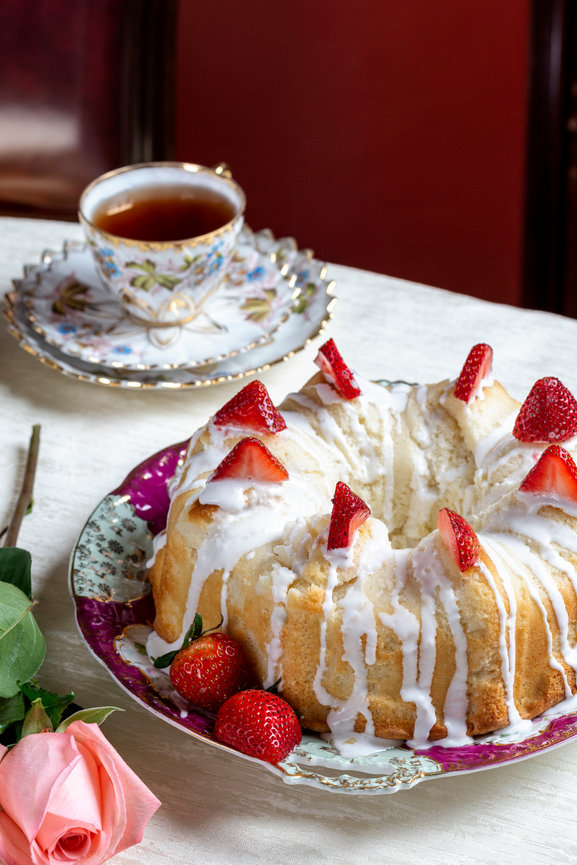Tall layer cakes were all the rage during the Victorian era, made light and airy with the newfangled ingredient called baking powder. One of the most popular was the Dolly Varden cake, named for the flirty, carefree young woman with colorful clothing and a broad-rimmed hat introduced in Charles Dickens’ 1841 book Barnaby Rudge.
Although I could not determine the cake’s original creator, it was said to have been invented by an American fan of the novel. Early versions called for three or even four layers of cake in various shades and flavors, meant to mirror Dolly’s vibrant dress. The earliest recipe I could find dates from an 1877 cookbook called Melrose Household Treasure and was very much in this style. The recipe instructs making two layers using egg whites only and tinting one half with confectioner's cochineal (a red food coloring made from the dried, pulverized bodies of an insect called the cochineal) to make a pink color. The other layers were made using egg yolks, with grated chocolate added to half the batter. The end result was multiple tiers of chocolate, white, rose and yellow cake. This was a fancy, special company cake:
DOLLY VARDEN CAKE.
One cup sugar, one-third cup butter, one-quarter cup milk, one full cup flour measured before sifting, whites of six eggs, one-quarter teaspoon soda, three-quarters cream tartar; bake half of this plain, the other half color with one-quarter teaspoon of confectioner's cochineal; flavor with rose water. Bake the same quantity of the receipt, using the yolks of the eggs, coloring one-half with one teacup of grated chocolate; bake in jelly tins; frost each layer with very thin frosting taking care not to get too much sugar; put together chocolate, whites, rose, and yellows. Very handsome and very good. Try it. Mrs. D. O. Morton.
Other Dolly Varden cakes featured two layers: one was a simple butter cake, sometimes flavored with lemon; the other was made with dried fruits and spices such as raisins, cherries, currants, cloves, cinnamon and nutmeg to represent Dolly’s colorful dress. The two layers were stacked on top of each other with a jam, meringue icing or buttercream frosting sandwiched in between and generously slathered on top. When the cake was cut and placed on a plate, the contrasting layers created a striking effect. Sometimes three layers were made, with the darker spicy layer placed in the middle.
This was the version I made; adapted from the diary of Ebenezer Maxwell Mansion's Anna's Maxwell:
Dolly Varden Cake
- 3 cups cake flour
- 2 cups sugar
- 2 sticks butter
- 3 eggs
- 2 tsp baking powder
- 1 cup milk
- 1/4 cup molasses
- 1 cup raisins
- 1 tsp cinnamon
- 1 tsp freshly grated nutmeg
- 1/4 tsp ground cloves
Sift flour and baking powder together, set aside. Cream butter and sugar until light. Then add eggs one at a time, beating well after each addition. Add flour mixture a little at a time, alternating with milk. Mix well. Divide dough in half and add remaining ingredients to one half. Pour batter into two greased and floured round cake pans and bake at 350F for 35-40 min or until a toothpick inserted into the center comes out clean. Cool on wire rack and then frost with the following boiled icing (also from Anna Maxwell):
- 2 cups of superfine granulated sugar
- 2 egg whites
- 1/2 tsp vanilla
Boil sugar four minutes with very little water (about a tablespoon). Then pour over the beaten whites and beat until very stiff . Flavor with the vanilla. Place the white layer on the bottom and spread with icing; then top with the spice layer and frost all over the top.
Dolly Varden from Dickens' Barnaby Rudge, as painted by William Powell Frith, 1842
The style continued on into the twentieth century, albeit with some alterations when the Depression hit and ingredients were scarce. As a result, recipes at the time called for less fruit, spice, milk and eggs and often substituted lard for butter. Later on in the century, other ingredients were introduced to coincide with what was trendy at the time, such as Maraschino cherries, cardamom, citron, walnuts and coconut.
Me and my "Dolly Varden" birthday cake, circa 1977
Toward the end of the 20th century, the Dolly Varden cake evolved into a girl’s birthday cake designed with a real doll perched on top of a cake made in the shape of her full skirt.It was sometimes then called “Fairy Tale Princess Cake,” “Dolly Cake,” “Princess Doll Cake,” or “Barbie Cake.” I actually had one of these for one of my birthday celebrations in the late 1970s. A family friend was taking a class and very generously offered to make it for me. I recall it as one of my favorite cakes ever!
To learn more about about this unique cake and other Victorian desserts named for people and places (and taste some delicious samples), join me at Philadelphia's Ebenezer Maxwell Mansion on March 20 from 1:30-3:30!
Sources: Cake: A Global History By Nicola Humble; Secrets of New England Cooking By Ella Shannon Bowles, Dorothy S. Towle; The Oxford Companion to Sugar and Sweets







0 Comments